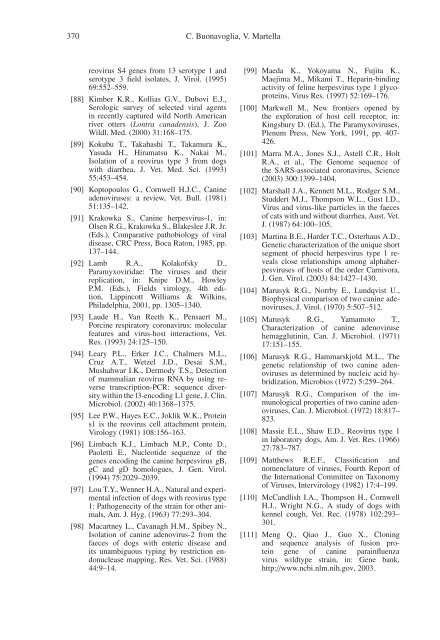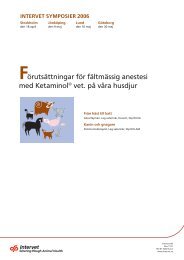KVÄLLSSYMPOSIUM 2008 Vaccinering av hund och katt
KVÄLLSSYMPOSIUM 2008 Vaccinering av hund och katt
KVÄLLSSYMPOSIUM 2008 Vaccinering av hund och katt
You also want an ePaper? Increase the reach of your titles
YUMPU automatically turns print PDFs into web optimized ePapers that Google loves.
370 C. Buon<strong>av</strong>oglia, V. Martella<br />
reovirus S4 genes from 13 serotype 1 and<br />
serotype 3 field isolates, J. Virol. (1995)<br />
69:552–559.<br />
[88] Kimber K.R., Kollias G.V., Dubovi E.J.,<br />
Serologic survey of selected viral agents<br />
in recently captured wild North American<br />
river otters (Lontra canadensis), J. Zoo<br />
Wildl. Med. (2000) 31:168–175.<br />
[89] Kokubu T., Takahashi T., Takamura K.,<br />
Yasuda H., Hiramatsu K., Nakai M.,<br />
Isolation of a reovirus type 3 from dogs<br />
with diarrhea, J. Vet. Med. Sci. (1993)<br />
55:453–454.<br />
[90] Koptopoulos G., Cornwell H.J.C., Canine<br />
adenoviruses: a review, Vet. Bull. (1981)<br />
51:135–142.<br />
[91] Krakowka S., Canine herpesvirus-1, in:<br />
Olsen R.G., Krakowka S., Blakeslee J.R. Jr.<br />
(Eds.), Comparative pathobiology of viral<br />
disease, CRC Press, Boca Raton, 1985, pp.<br />
137–144.<br />
[92] Lamb R.A., Kolakofsky D.,<br />
Paramyxoviridae: The viruses and their<br />
replication, in: Knipe D.M., Howley<br />
P.M. (Eds.), Fields virology, 4th edition,<br />
Lippincott Williams & Wilkins,<br />
Philadelphia, 2001, pp. 1305–1340.<br />
[93] Laude H., Van Reeth K., Pensaert M.,<br />
Porcine respiratory coron<strong>av</strong>irus: molecular<br />
features and virus-host interactions, Vet.<br />
Res. (1993) 24:125–150.<br />
[94] Leary P.L., Erker J.C., Chalmers M.L.,<br />
Cruz A.T., Wetzel J.D., Desai S.M.,<br />
Mushahwar I.K., Dermody T.S., Detection<br />
of mammalian reovirus RNA by using reverse<br />
transcription-PCR: sequence diversity<br />
within the l3-encoding L1 gene, J. Clin.<br />
Microbiol. (2002) 40:1368–1375.<br />
[95] Lee P.W., Hayes E.C., Joklik W.K., Protein<br />
s1 is the reovirus cell attachment protein,<br />
Virology (1981) 108:156–163.<br />
[96] Limbach K.J., Limbach M.P., Conte D.,<br />
Paoletti E., Nucleotide sequenze of the<br />
genes encoding the canine herpesvirus gB,<br />
gC and gD homologues, J. Gen. Virol.<br />
(1994) 75:2029–2039.<br />
[97] Lou T.Y., Wenner H.A., Natural and experimental<br />
infection of dogs with reovirus type<br />
1: Pathogenecity of the strain for other animals,<br />
Am. J. Hyg. (1963) 77:293–304.<br />
[98] Macartney L., C<strong>av</strong>anagh H.M., Spibey N.,<br />
Isolation of canine adenovirus-2 from the<br />
faeces of dogs with enteric disease and<br />
its unambiguous typing by restriction endonuclease<br />
mapping, Res. Vet. Sci. (1988)<br />
44:9–14.<br />
[99] Maeda K., Yokoyama N., Fujita K.,<br />
Maejima M., Mikami T., Heparin-binding<br />
activity of feline herpesvirus type 1 glycoproteins,<br />
Virus Res. (1997) 52:169–176.<br />
[100] Markwell M., New frontiers opened by<br />
the exploration of host cell receptor, in:<br />
Kingsbury D. (Ed.), The Paramyxoviruses,<br />
Plenum Press, New York, 1991, pp. 407-<br />
426.<br />
[101] Marra M.A., Jones S.J., Astell C.R., Holt<br />
R.A., et al., The Genome sequence of<br />
the SARS-associated coron<strong>av</strong>irus, Science<br />
(2003) 300:1399–1404.<br />
[102] Marshall J.A., Kennett M.L., Rodger S.M.,<br />
Studdert M.J., Thompson W.L., Gust I.D.,<br />
Virus and virus-like particles in the faeces<br />
of cats with and without diarrhea, Aust. Vet.<br />
J. (1987) 64:100–105.<br />
[103] Martina B.E., Harder T.C., Osterhaus A.D.,<br />
Genetic characterization of the unique short<br />
segment of phocid herpesvirus type 1 reveals<br />
close relationships among alphaherpesviruses<br />
of hosts of the order Carnivora,<br />
J. Gen. Virol. (2003) 84:1427–1430.<br />
[104] Marusyk R.G., Norrby E., Lundqvist U.,<br />
Biophysical comparison of two canine adenoviruses,<br />
J. Virol. (1970) 5:507–512.<br />
[105] Marusyk R.G., Yamamoto T.,<br />
Characterization of canine adenoviruse<br />
hemagglutinin, Can. J. Microbiol. (1971)<br />
17:151–155.<br />
[106] Marusyk R.G., Hammarskjold M.L., The<br />
genetic relationship of two canine adenoviruses<br />
as determined by nucleic acid hybridization,<br />
Microbios (1972) 5:259–264.<br />
[107] Marusyk R.G., Comparison of the immunological<br />
properties of two canine adenoviruses,<br />
Can. J. Microbiol. (1972) 18:817–<br />
823.<br />
[108] Massie E.L., Shaw E.D., Reovirus type 1<br />
in laboratory dogs, Am. J. Vet. Res. (1966)<br />
27:783–787.<br />
[109] Matthews R.E.F., Classification and<br />
nomenclature of viruses, Fourth Report of<br />
the International Committee on Taxonomy<br />
of Viruses, Intervirology (1982) 17:4–199.<br />
[110] McCandlish I.A., Thompson H., Cornwell<br />
H.J., Wright N.G., A study of dogs with<br />
kennel cough, Vet. Rec. (1978) 102:293–<br />
301.<br />
[111] Meng Q., Qiao J., Guo X., Cloning<br />
and sequence analysis of fusion protein<br />
gene of canine parainfluenza<br />
virus wildtype strain, in: Gene bank,<br />
http://www.ncbi.nlm.nih.gov, 2003.





